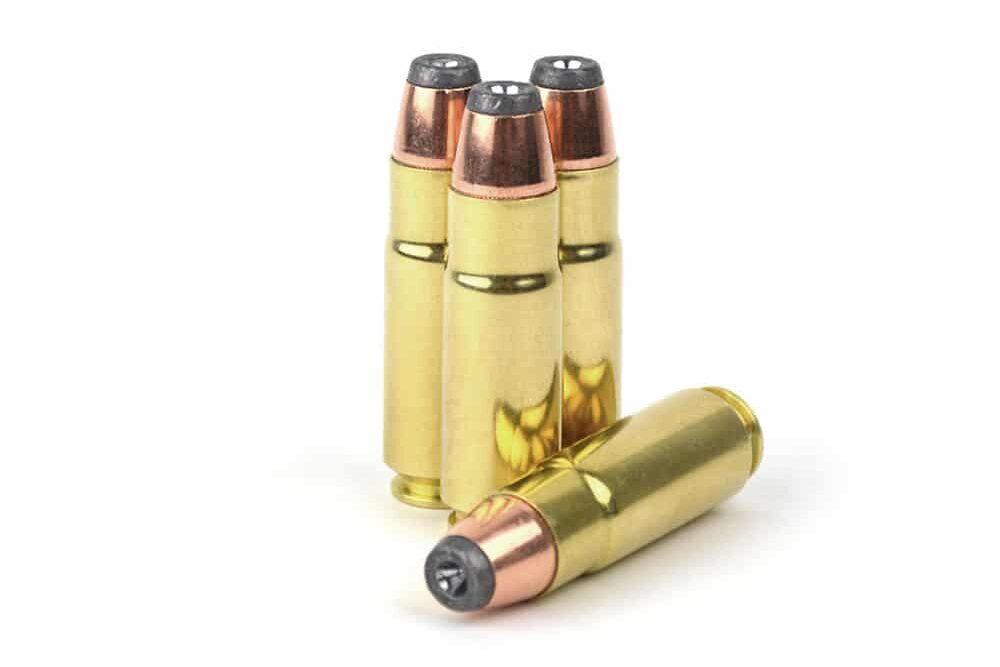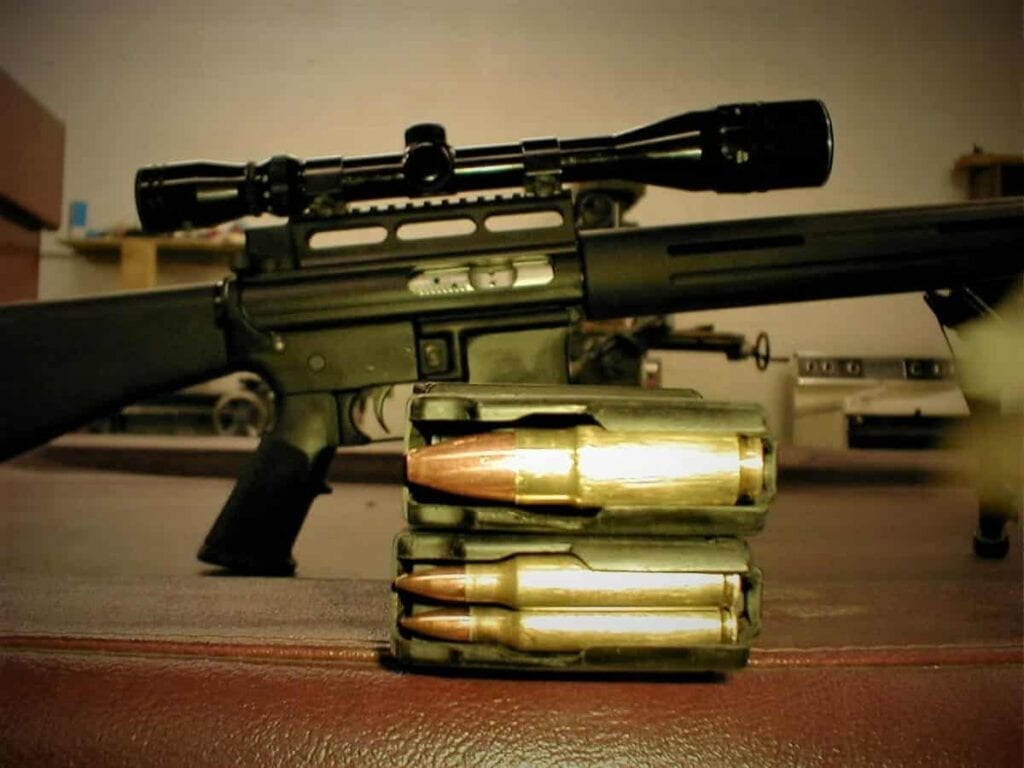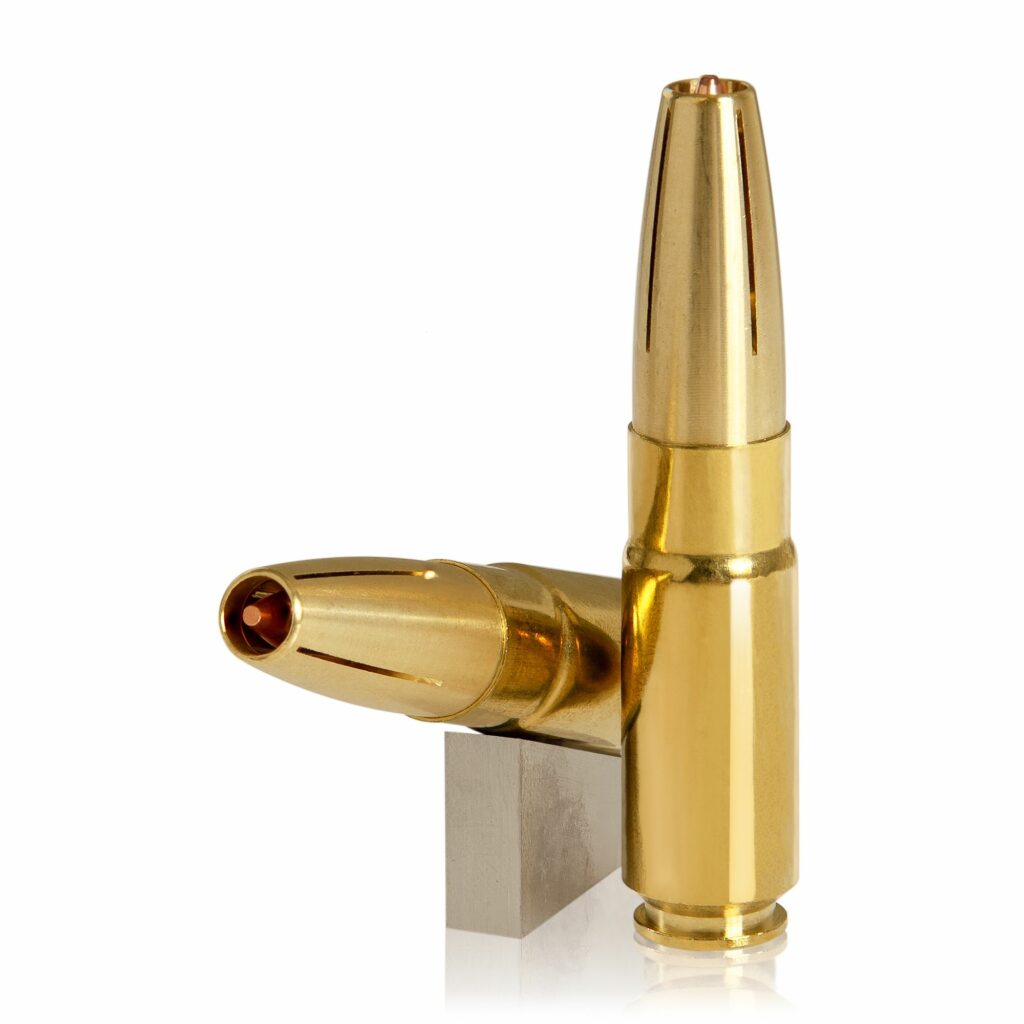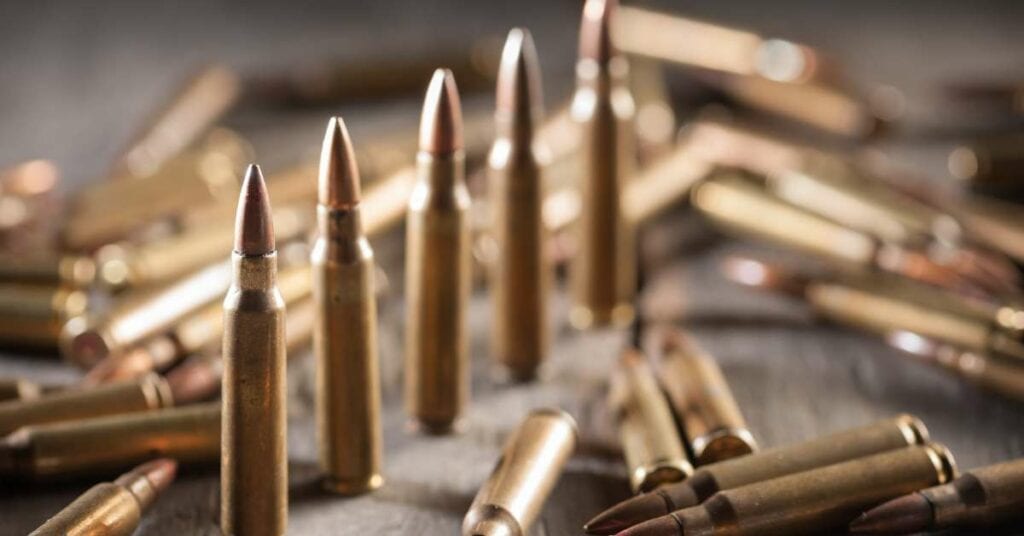The .50 Beowulf and .458 SOCOM were designed in the same year 2001 and were developed for almost the same purpose. Converting an AR-15 or M16 into a hard hitting heavy caliber rifle. The difference was the intended use by civilians for the .50 Beowulf and the military for .458 SOCOM. However, both calibers are still obscure but surviving on the market. Take a detailed look at the data to compare these rounds and find out if one of these is for you.
50 Beowulf vs 458 SOCOM
A quick, side-by-side comparison of the .50 Beowulf and .458 SOCOM cartridges for their pros, cons and best uses.

50 Beowulf

458 SOCOM

Pros
50 Beowulf
Quite economical compared to similar rounds
Big caliber with semi-auto capability in an SBR
Great for hunting big game at very short range
Quickly convert an AR-15 into a hard-hitting .50 cal rifle
Easy integration into the AR-15 platform using same mags
458 SOCOM
Suitable for SBR and lightweight rifles
Capable of being used in semi-auto rifles
Good range of ammo and reloading options
Amazing energy retention and trajectory out to 300 yards
Developed for the military SOCOM and adopted in low capacity
Designed for the M4/M-16 platform and can use same 5.56 mags
Cons
50 Beowulf
Rifles have to be a bit heavy
Less ammo and reloading options
Can be difficult to find on the market
Proprietary cartridge so lesser development
458 SOCOM
Ammo is quite expensive
Availability can sometimes be an issue
Prone to overpenetration in tactical applications
Best For
50 Beowulf
Good for AR-15 users who want a quick-swapping heavy caliber upper for occasional hunting or plinking
458 SOCOM
Great for AR-15 owners looking for a more versatile heavy caliber for hunting or tactical use.
50 Beowulf Overview
The .50 Beowulf (12.7×42 mm) was developed in 2001 by Bill Alexander of Alexander Arms. The sole purpose of this development was to bring a bigger caliber cartridge that could be fired from an AR-15 platform. This cartridge is the equivalent of a .500 S&W Magnum cartridge in appearance and possesses the power equal to a .45-70 government round.
This cartridge is proprietary and the rights for manufacture are jointly owned by Alexander Arms and Delta Firearms, whereas the .50 Beowulf trademark is owned by Alexander Arms. This round was developed to be a hard-hitting short range ammo choice for AR-15 owners. A simple swap of the upper receiver can instantly convert an AR-15 from a varmint killing caliber rifle to a moose buster.

The .50 Beowulf has almost the same rim diameter and can use the same bolt as the 6.5 Grendel round with a changed extractor. Both these rounds are put in the novel category of ammunition and have been quite dormant in terms of popularity over the years. A major contributing reason to this is the availability of more versatile and tested cartridges with the same performance factor.
This cartridge has not been too popular all along, but its compatibility with the AR-15 platform and the affinity of the masses towards short barreled rifles have allowed it to gain some traction recently.
458 SOCOM Overview
The .458 SOCOM is a cartridge that got off to a rocket start but did not reach space and is lurking somewhere in the orbit. Designed by Marty ter Weeme of Teppo Jutsu and Tony Rumore of Tromix in 2000 and the company was contracted in 2001 to build the first rifle the next year.
This cartridge gets its name from the prospective client it was designed for, the United States Special Operations Command. Weeme and a high ranking official of SOCOM were having a conversation when the topic of the ineffectiveness of the 5.56 NATO rounds on drug intoxicated Somali rebels came up.

The need for a more potent and powerful round that could easily fit in the M4/M16 platform without much change was needed. That’s what ended up to be the .458 SOCOM. This cartridge was adopted in a limited capacity by some units of the United States Military but never saw wide-scale deployment.
Although the .458 caliber was not new for the military as it had seen some action in the Vietnam war, the .458 SOCOM was a short action round and saw some use as an anti-vehicle round at checkposts in Iraq and Afghanistan.
Lately, this round has started to gain a lot of traction among the hunting community. Especially among AR-15 platform lovers.
50 Beowulf vs 458 SOCOM: Cartridge Specs
Check out a quick side-by-side comparison of the cartridge dimensions and loading specifications for both these rounds.
 | 50 Beowulf | 458 SOCOM |
|---|---|---|
| Bullet Diameter | .500 in (12.7 mm) | 0.458 in (11.63 mm) |
| Neck Diameter | .525 in (13.3 mm) | 0.458 in (12.32 mm) |
| Base Diameter | .535 in (13.6 mm) | 0.541 in (13.74 mm) |
| Case Length | 1.65 in (42 mm) | 1.575 in (40 mm) |
| Overall Length | 2.125 in (54.0 mm) | 2.260 in (57.40 mm) |
| Case Capacity | 65.8 grains | 61.1 grains |
| Max Pressure | 33,000 psi (not SAAMI) | 35,000 psi (not SAAMI) |
| Typical Casing Material | Brass | Brass |
| Typical Bullet Weight (gr) | 300-400 grains | 250-350 grains |
The .50 Beowulf and .458 SOCOM use a .50AE parent case and are almost similar in overall length and case capacity. However, the .50 Beowulf is a straight case, the .458 SOCOM uses a slightly bottlenecked case design.
The .50 Beowulf uses a slightly larger diameter bullet of .500 inches, whereas the .458 SOCOM uses a 0.458-inch diameter bullet. This difference in size affects the outcome of the wound channel and a minor difference in hitting power, which we will discuss in the next sections.
A big similarity between these two rounds is their compatibility with the AR-15/M4 rifle platform. Both these rounds can fit 5.56 NATO magazines. A 30 round mag can fit 10 of these and a 20 round mag can fit seven rounds each of these cartridges.
Despite their large caliber, these cartridges have been designed to reliably shoot from a semi-auto platform. While the .50 Beowulf offers bullet weights in the range of 300 to 500 grains, the .458 SOCOM offers a more versatile selection ranging from 250 to 600 grains.
It is also important to note that neither of these cartridges has been rated by SAAMI for pressure limits.

50 Beowulf vs 458 SOCOM: Ballistics
This ballistics section will cover the flight path, speed, and energy characteristics of the bullet when fired from the rifle. The ballistics data will help us understand if a cartridge is suitable for long/short range, big/small targets, and the level of accuracy it can deliver.
This section will cover three specific points – the trajectory, velocity, and stopping power of these rounds.
50 Beowulf vs 458 SOCOM: Trajectory
Let us first compare the trajectory characteristics of both these rounds. The rifles have been zeroed at 100 yards and use a 16-inch barrel which is the most preferred length for these cartridges.
50 Beowulf
| 16” barrel/BC 0.200/300 gr Speer Gold Dot | 24” barrel/BC 0.210/335 gr Rainier Hollow Point | 16”barrel//BC 0.202/400 gr Hawk Soft Point |
|---|---|---|
| 50 yds: 0.25“ High | 50 yds: 0.16“ Drop | 50 yds: 0.14“ Drop |
| 100 yds: 0“ Drop | 100 yds: 0“ Drop | 100 yds: 0“ Drop |
| 150 yds: 4.78“ Drop | 150 yds: 3.08“ Drop | 150 yds: 4.15“ Drop |
| 200 yds: 15.35“ Drop | 200 yds: 10.10“ Drop | 200 yds: 13.20“ Drop |
| 250 yds: 33.03“ Drop | 250 yds: 21.87“ Drop | 250 yds: 28.11“ Drop |
| 300 yds: 59.05“ Drop | 300 yds: 39.35“ Drop | 300 yds: 49.33“ Drop |
| 400 yds: 140.65“ Drop | 400 yds: 95.29“ Drop | 400 yds: 118.08“ Drop |
458 SOCOM
| 16” barrel/BC 0.236/300 gr Barnes TTSX | 16” barrel/BC 0.232/350 gr JFN | 16” barrel/BC 0.259/400 gr Barnes TTSX |
|---|---|---|
| 50 yds: 0.79“ High | 50 yds: 0.91“ High | 50 yds: 0.89“ High |
| 100 yds: 0“ Drop | 100 yds: 0“ Drop | 100 yds: 0“ Drop |
| 150 yds: 3.53“ Drop | 150 yds: 3.97“ Drop | 150 yds: 3.84“ Drop |
| 200 yds: 10.31“ Drop | 200 yds: 11.59“ Drop | 200 yds: 11.13“ Drop |
| 250 yds: 20.96“ Drop | 250 yds: 23.54“ Drop | 250 yds: 22.44“ Drop |
| 300 yds: 36.18“ Drop | 300 yds: 40.63“ Drop | 300 yds: 38.47“ Drop |
| 400 yds: 83.7“ Drop | 400 yds: 93.75“ Drop | 400 yds: 87.7“ Drop |
Looking at the drop characteristics of both these cartridges, it is pretty much clear that neither of these is suitable for long range use. The case capacity, powder loads, and bullet types make these rounds good for use within 300 yards max. Perhaps more experts will agree that these rounds are suitable for use under 250 yards only.
I only included data from short barrels like 16 inch because a 24 inch barrel is not very suitable for a round that has been made for the AR-15 platform and short range use. Additionally, the difference in the drop isn’t significant within the effective range.
With a side-by-side comparison of comparable bullet weights, it is certainly very clear that the .458 shoots flatter than the .50 Beowulf. The drop characteristics of both these bullets within a range of 200 yards are great with respect to their heavy weights and will provide good accuracy.
The difference in drop characteristics between these bullets out to 200 yards is insignificant. Although the .458 SOCOM still has a slight edge, you will not see a major difference.
50 Beowulf vs 458 SOCOM: Velocity & Kinetic Energy
Comparing the .50 Beowulf and .458 SOCOM for speed and characteristics delivered some interesting data. Let’s understand this:
50 Beowulf
| 16” barrel/BC 0.200/300 gr Speer Gold Dot | 24” barrel/BC 0.210/335 gr Rainier Hollow Point | 16”barrel//BC 0.202/400 gr Hawk Soft Point |
|---|---|---|
| 50 yds: 1,580 ft/s, 1,664 ft.lbs | 50 yds: 1,804 ft/s, 2,414 ft.lbs | 50 yds: 1,629 ft/s, 2,359 ft.lbs |
| 100 yds: 1,387 ft/s, 1,282 ft.lbs | 100 yds: 1,639 ft/s, 1,994 ft.lbs | 100 yds: 1,473 ft/s, 1,929 ft.lbs |
| 150 yds: 1,226 ft/s, 1,002 ft.lbs | 150 yds: 1,488 ft/s, 1,643 ft.lbs | 150 yds: 1,335 ft/s, 1,582 ft.lbs |
| 200 yds: 1,105 ft/s, 814 ft.lbs | 200 yds: 1,352 ft/s, 1,357 ft.lbs | 200 yds: 1,216 ft/s, 1,315 ft.lbs |
| 250 yds: 1,020 ft/s, 693 ft.lbs | 250 yds: 1,235 ft/s, 1,132 ft.lbs | 250 yds: 1,122 ft/s, 1,118 ft.lbs |
| 300 yds: 957 ft/s, 610 ft.lbs | 300 yds: 1,140 ft/s, 964 ft.lbs | 300 yds: 1,050 ft/s, 980 ft.lbs |
| 400 yds: 862 ft/s, 495 ft.lbs | 400 yds: 1,009 ft/s, 756 ft.lbs | 400 yds: 949 ft/s, 801 ft.lbs |
458 SOCOM
| 16” barrel/BC 0.236/300 gr Barnes TTSX | 16” barrel/BC 0.232/350 gr JFN | 16” barrel/BC 0.259/400 gr Barnes TTSX |
|---|---|---|
| 50 yds: 1,936 ft/s, 2,498 ft.lbs | 50 yds: 1,839 ft/s, 2,628 ft.lbs | 50 yds: 1,855 ft/s, 3,057 ft.lbs |
| 100 yds: 1,782 ft/s, 2,115 ft.lbs | 100 yds: 1,687 ft/s, 2,212 ft.lbs | 100 yds: 1,718 ft/s, 2,621 ft.lbs |
| 150 yds: 1,636 ft/s, 1,783 ft.lbs | 150 yds: 1,546 ft/s, 1,857 ft.lbs | 150 yds: 1,589 ft/s, 2,242 ft.lbs |
| 200 yds: 1,501 ft/s, 1,501 ft.lbs | 200 yds: 1,416 ft/s, 1,559 ft.lbs | 200 yds: 1,469 ft/s, 1,916 ft.lbs |
| 250 yds: 1,378 ft/s, 1,265 ft.lbs | 250 yds: 1,301 ft/s, 1,315 ft.lbs | 250 yds: 1,359 ft/s, 1,641 ft.lbs |
| 300 yds: 1,269 ft/s, 1,073 ft.lbs | 300 yds: 1,202 ft/s, 1,123 ft.lbs | 300 yds: 1,262 ft/s, 1,414 ft.lbs |
| 400 yds: 1,102 ft/s, 810 ft.lbs | 400 yds: 1,058 ft/s, 870 ft.lbs | 400 yds: 1,109 ft/s, 1,093 ft.lbs |
All the loads taken here for comparison are supersonic for better accuracy and also optimal estimation of data. The heaviest loads from .458 SOCOM (`600 grains) are generally supersonic due to their weight characteristics.
Factoring the data, it is clear that the .458 SOCOM is a slightly faster round than the .50 Beowulf. However, the difference is not too much right off the muzzle and shrinks uniformly as the range progresses.
Both these rounds stay supersonic out to 200 yards, whereas the .458 SOCOM stays supersonic for another 100 yards due to its higher velocity. So it does have a slight advantage, and why not, afterall it was designed for the special forces.
Talking about energy, these .50 cals, and .459 cal bullets were purposely designed to deliver a humongous amount of energy at close range. The .50 Beowulf delivers about 2,500 fpe of energy at the muzzle, whereas the .458 SOCOM delivers about 2,800 fpe at the muzzle.
If you closely compare the energy characteristics of both these cartridges, the .458 SOCOM again has a big edge over the .50 Beowulf. The low grain bullets are pretty much inadequate for bigger targets, but bullet weights above 330 grains are decimating out to a range of 200 yards carrying an average of 1,500 fpe of energy. This much energy is considered to be the theoretical minimum for taking down big Class 3 game like elk and moose.
50 Beowulf vs 458 SOCOM: Stopping Power
The stopping power of a bullet describes its ability to stop/kill a target by causing maximum damage upon impact. This damage is calculated on the basis of a couple of factors which are penetration and fragmentation.
Generally, bigger bullets will create bigger wound channels and may seem to cause much more damage. However, the bullet’s mass to cross section area ratio (Sectional Density) plays a factor here. Learn about this and more in this section.
50 Beowulf vs 458 SOCOM: Momentum & Sectional Density
A brief comparison of the momentum characteristics of these bullets out to a range of 400 yards.
50 Beowulf
| 16” barrel/BC 0.200/300 gr Speer Gold Dot Sectional Density: 0.171 | 24” barrel/BC 0.210/335 gr Rainier Hollow Point Sectional Density: 0.191 | 16”barrel//BC 0.202/400 gr Hawk Soft Point Sectional Density: 0.229 |
|---|---|---|
| 50 yds: 67 lb-s | 50 yds: 86 lb-s | 50 yds: 93 lb-s |
| 100 yds: 59 lb-s | 100 yds: 78 lb-s | 100 yds: 84 lb-s |
| 150 yds: 52 lb-s | 150 yds: 71 lb-s | 150 yds: 76 lb-s |
| 200 yds: 47 lb-s | 200 yds: 64lb-s | 200 yds: 69 lb-s |
| 250 yds: 43 lb-s | 250 yds: 59 lb-s | 250 yds: 64 lb-s |
| 300 yds: 41 lb-s | 300 yds: 54 lb-s | 300 yds: 60 lb-s |
| 400 yds: 36 lb-s | 400 yds: 48 lb-s | 400 yds: 54 lb-s |
458 SOCOM
| 16” barrel/BC 0.236/300 gr Barnes TTSX Sectional Density: 0.204 | 16” barrel/BC 0.232/350 gr JFN Sectional Density: 0.238 | 16” barrel/BC 0.259/400 gr Barnes TTSX Sectional Density: 0.272 |
|---|---|---|
| 50 yds: 82 lb-s | 50 yds: 91 lb-s | 50 yds: 106 lb-s |
| 100 yds: 76 lb-s | 100 yds: 84 lb-s | 100 yds: 98 lb-s |
| 150 yds: 70 lb-s | 150 yds: 77 lb-s | 150 yds: 90 lb-s |
| 200 yds: 64 lb-s | 200 yds: 70 lb-s | 200 yds: 84 lb-s |
| 250 yds: 59 lb-s | 250 yds: 65 lb-s | 250 yds: 77 lb-s |
| 300 yds: 54 lb-s | 300 yds: 60 lb-s | 300 yds: 72 lb-s |
| 400 yds: 47 lb-s | 400 yds: 52 lb-s | 400 yds: 63 lb-s |
The term Sectional Density (SD) describes the mass to cross-sectional area ratio of an object. The higher the SD, the more penetration will be caused by a bullet. According to the general rule of thumb, SD less than 0.220 is good for varmints, an SD of .220 to 0.270 is good for a medium sized game like deer, and an SD above that is good for Class 3 game.
Looking at the data, the .50 Beowulf cartridges should use at least a 400-grain bullet to be considerable for a medium-sized game. On the other hand, the .458 SOCOM bullets above 350 grains are great for deer and heavier game. The heaviest .458 SOCOM bullets (550 gr+) can handle the biggest of game animals roaming the planet.
The next factor to consider is the momentum of the bullet. It describes the degree of energy transfer from the bullet to the impacting object. The higher this number, the more tissue damage. Again, the .458 SOCOM is the clear winner as far as momentum is considered. Although, the difference between these two is not too much, and both these rounds are great within 250-300 yards.
50 Beowulf vs 458 SOCOM: Use Cases & Effective Range
Both of these are fairly new cartridges on the market when compared to the other venerable options proving their mettle for decades. However, there are some situations where these rounds are really good.
Short Range K.O Punch
Both these cartridges were exclusively designed for short range use. The .50 Beowulf was designed to quickly convert a coyote-killing AR-15 into a ‘thor’s hammer’. Essentially being capable of penetrating objects like auto glass and thin armor. The round is no doubt very good at that while maintaining the design integrity of the AR-15 rifle.
The .458 SOCOM was a special round crafted for special forces to tackle drug-high hostiles. This round punches a bit harder and the heaviest bullets retain a lot of energy out to 400 yards. Both these rounds are great for short range (<200 yards) combat engagements and defense in the woods.
Hunting vs Combat vs Home Defense
The .50 Beowulf is useful for hunting down deer with heavy bullets (>400 grains) within a range of 250 yards, whereas the .458 SOCOM is a more versatile round that can take down any game out to 300 yards with heavy bullets.

As far as tactical combat use is concerned, the .458 SOCOM is a clear winner because it was designed for that and features such characteristics like we compared above. The .50 Beowulf has earned a reputation as a hard-hitting hunting round and is popular mostly because it can be easily integrated into the AR-15 platform.
As both these rounds are intended for short range, hard-hitting use, a person might think of using these for home defense. In my opinion, these rounds should never be used for home defense. Not unless you live alone in a cabin out in the woods or have thick brick walls around. That’s because these bullets will cause overpenetration and have significant recoil energy.
Any Scope for Competition Use?
It rather depends upon the choice of the shooter and if the competition rules allow using these heavy calibers for short range use. Neither of these rounds is great for any competitions, despite being semi-auto rifle cartridges.
Miscellaneous Uses
Being hard hitting big bullets with immense amounts of energy and capable of being fired from an AR-15 with only the swap of the upper receiver. These cartridges are also suitable contenders for use in prepper rifles or any other uncommon scenarios (like a truck gun or guide gun). However, keep into consideration the high recoil force.
50 Beowulf vs 458 SOCOM: Costs, Availability, & Compatibility
Take a look at the feasibility of owning either of these cartridges.
Sometimes Pricey, Sometimes Rare
Before you choose either of these cartridges, I must inform you that neither of these is SAAMI approved, so very few manufacturers make them. Additionally, the supply-demand factor also comes into play. The .50 Beowulf is a less popular round and is a bit rare to be found in gun shops with a price tag between $1.75 to $4 per round.

The .458 SOCOM is a more popular cartridge due to its military history and is a bit more occasional on gun shops, but not too much. It is more expensive and can be found at a price between $2.75 to $4.5 per round.
Great Compatibility and Aftermarket Options
Both these rounds were designed for use in the AR-15 platform with the simple swap of the upper.
These cartridges can fit into a regular 5.56/.223 AR-15 magazine at almost one-third its capacity. Additionally, the AR-15 is a popular platform and has literally a ton of upgrade and accessory options available.
Bottom Line
As far as popularity is concerned, the .458 SOCOM has an upper hand due to its acceptance by the military and slightly better availability of ammo/rifles. Taking into consideration the ballistics data, both these rounds are extremely hard-hitting with heavy grain bullets within 250 yards. However, the .458 SOCOM is ballistically a better round with a flatter trajectory, more energy & its retention, better penetration, and higher stopping power. Although that comes at a higher per round price.
Additionally, the .458 SOCOM is clearly more popular than the .50 Beowulf with more ammo and reloading options. The .50 Beowulf is great for AR-15 users who want to slap a heavy caliber upper for plinking or occasional hunting.
People Also Ask
Clear a few of your doubts and learn a couple of new facts about the .458 SOCOM and .50 Beowulf cartridges.
No. The United States or any other military in the world does not use the .50 Beowulf. It is a proprietary cartridge that can be easily assimilated with the AR-15 platform and fires a .50 cal bullet. However, its use is only limited to hunting applications and that too by a very slim number of users.
The .458 SOCOM is an amazing hunting and combat round. If surroundings allow, it can also be used for home defense applications. This round is extremely good at penetrating thin armor and will incapacitate a charging hostile high on drugs with just one or two shots.
While the widespread use of these cartridges among the infantry or special forces was never seen. It is true that some special forces teams did and do use this cartridge occasionally depending upon the type of mission. Although the cartridge has not been officially adopted for large scale use probably due to mag capacity limitations.


